| Sonnet 14 | |||||||
|---|---|---|---|---|---|---|---|
 The first twelve lines of Sonnet 14 in the 1609 Quarto | |||||||
| | |||||||
| |||||||
Sonnet 14 is one of 154 sonnets written by the English playwright and poet William Shakespeare. It is a procreation sonnet within the Fair Youth sequence.
| Sonnet 14 | |||||||
|---|---|---|---|---|---|---|---|
 The first twelve lines of Sonnet 14 in the 1609 Quarto | |||||||
| | |||||||
| |||||||
Sonnet 14 is one of 154 sonnets written by the English playwright and poet William Shakespeare. It is a procreation sonnet within the Fair Youth sequence.
Sonnet 14 is an English or Shakespearean sonnet, which consists of three quatrains followed by a couplet. It follows the traditional rhyme scheme of the form: ABAB CDCD EFEF GG. Like many of the others in the sequence, it is written in a type of metre called iambic pentameter, which is based on five pairs of metrically weak/strong syllabic positions per line.
Typically English sonnets present a problem or argument in the quatrains, and a resolution in the final couplet. [2] This sonnet suggests this pattern, but its rhetorical structure is more closely modeled upon the older Petrarchan sonnet which arranges the octave (the first eight lines) in contrast to the sestet (the final six lines).
Line 3 exemplifies a regular iambic pentameter:
× / × / × / × / × / But not to tell of good, or evil luck, (14.3)
Some critics argue that the Fair Youth sequence follows a story-line told by Shakespeare. [3] Evidence that corroborates this is that the sonnets show a constant change of attitude that would seem to follow a day-by-day private journal entry. [3] Furthermore, there is an argument that the Fair Youth sequence was written to Henry Wriothesley, 3rd Earl of Southampton. [4] Critics believe that Shakespeare would like him to marry and have an heir so that his beauty would live forever. [5] To this day the relationship between Henry Wriothesly and Shakespeare is debated due to the fact that some believe it was romantic in nature, and not platonic. [6] Regardless most critics agree that Shakespeare wrote this sonnet in order to convince him to produce an heir. [5]
Sonnet 14 contains a speaker that may not know how to predict the future or what will happen, but they do know the value of procreating to retain one's beauty throughout the ages.
Quatrain 1 has multiple references to astronomy, and other literature. Edward Dowden argues that Philip Sidney's Astrophel and Stella is an influence in this sonnet due to the nature of both of the sonnets. [7] For example, Sonnet 26 of Sidney's Astrophel and Stella has a line "though duskie wits doe scorne Astrology.. who oft bewares my after following case, by only those two starres in Stella's face." [8] A. L. Rowse points out in both of these poems the speaker is unable to predict the future by using astrology, and can only predict the future through the object of their poem's eyes. [9]
According to Frederick Fleays, lines 3-4 are possible references to plagues that occurred in 1592–1593, and the dearths that followed in 1594–1596. [10] Alfread Rollins also states there was an irregularity in the seasons in 1595–1596, which all could have influenced these lines from Shakespeare. [11]
Lines 8–9 have influences from Ovid's Amores and Shakespeare's own "Love Labor's Lost". George Steevens points out that Shakespeare's early comedy included a line stating "From women's eyes this doctrine I derive." [12] In the context of Sonnet 14 it is explaining the importance of procreation, and that it is necessary. [11] Ovid's Amores has a similar line "at mihe te comitem auroras usque futuram- per me perque oculos, siders rostra, tuos." [13] Both Samuel Johnson and George Steevens noted the similar meaning and that it indicates Roman influence on Shakespeare's poetry. [12]
Lines 10-11 are saying that one can see that truth and beauty would thrive together; if only you would focus on the business of making provisions for yourself. [14]
Shakespeare uses the portentous polysyllabic verb prognosticate with the alliteration 'doom and date' which is the stock in the trade of astrologers. [15] This is Shakespeare's prognostication, and it is delivered with a smile. West believed this due to the emphasis against the metre on 'this'. [15] Line 14 is saying that when one is dead, their truths and beauties come to an end as well. [14]

Sonnet 2 is one of 154 sonnets written by the English playwright and poet William Shakespeare. It is a procreation sonnet within the Fair Youth sequence.

Sonnet 3 is one of 154 sonnets written by the English playwright and poet William Shakespeare. It is often referred to as a procreation sonnet that falls within the Fair Youth sequence.

Sonnet 60 is one of 154 sonnets written by the English playwright and poet William Shakespeare. It's a member of the Fair Youth sequence, in which the poet expresses his love towards a young beloved.
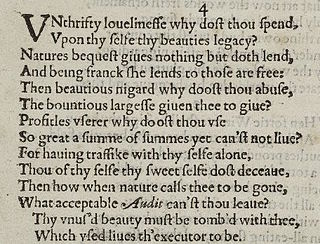
Sonnet 4 is one of 154 sonnets written by the English playwright and poet William Shakespeare. It is a procreation sonnet within the Fair Youth sequence.
Sonnet 5 is one of 154 sonnets written by the English playwright and poet William Shakespeare. It is a procreation sonnet within the Fair Youth sequence. Sonnet 5 is linked to Sonnet 6, which continues the theme of distillation.
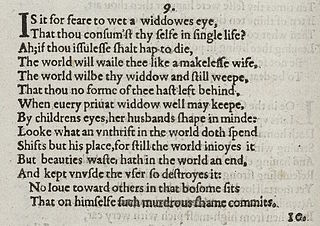
Sonnet 9 is one of 154 sonnets written by the English playwright and poet William Shakespeare. It is a procreation sonnet within the Fair Youth sequence.

Sonnet 10 is one of 154 sonnets written by the English playwright and poet William Shakespeare. It is a procreation sonnet within the Fair Youth sequence.

Sonnet 11 is one of 154 sonnets written by the English playwright and poet William Shakespeare. It is a procreation sonnet within the 126 sonnets of the Fair Youth sequence, a grouping of Shakespeare's sonnets addressed to an unknown young man. While the order in which the sonnets were composed is undetermined, Sonnet 11 was first published in a collection, the Quarto, alongside Shakespeare's other sonnets in 1609.

Sonnet 12 is one of 154 sonnets written by the English playwright and poet William Shakespeare. It is a procreation sonnet within the Fair Youth sequence.

Sonnet 15 is one of 154 sonnets written by the English playwright and poet William Shakespeare. It forms a diptych with Sonnet 16, as Sonnet 16 starts with "But...", and is thus fully part of the procreation sonnets, even though it does not contain an encouragement to procreate. The sonnet is within the Fair Youth sequence.
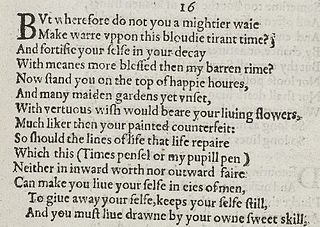
Sonnet 16 is one of 154 sonnets written by the English playwright and poet William Shakespeare. It is among those sonnets referred to as the procreation sonnets, within the Fair Youth sequence.

Sonnet 19 is one of 154 sonnets published by the English playwright and poet William Shakespeare in 1609. It is considered by some to be the final sonnet of the initial procreation sequence. The sonnet addresses time directly, as it allows time its great power to destroy all things in nature, but the poem forbids time to erode the young man's fair appearance. The poem casts time in the role of a poet holding an “antique pen”. The theme is redemption, through poetry, of time's inevitable decay. Though there is compunction in the implication that the young man himself will not survive time's effects, because redemption brought by the granting of everlasting youth is not actual, but rather ideal or poetic.

Sonnet 22 is one of 154 sonnets written by the English playwright and poet William Shakespeare, and is a part of the Fair Youth sequence.
Sonnet 24 is one of 154 sonnets written by the English playwright and poet William Shakespeare, and is a part of the Fair Youth sequence.
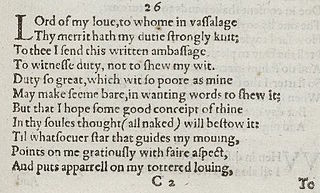
Sonnet 26 is one of 154 sonnets written by the English playwright and poet William Shakespeare, and is a part of the Fair Youth sequence.

Shakespeare's Sonnet 33 is one of 154 sonnets written by the English playwright and poet William Shakespeare. It is a member of the Fair Youth sequence, in which the poet expresses his love towards a young man. This sonnet is the first of what are sometimes called the estrangement sonnets, numbers 33–36: poems concerned with the speaker's response to an unspecified "sensual fault" mentioned in (35) committed by his beloved.

William Shakespeare's Sonnet 35 is part of the Fair Youth sequence, commonly agreed to be addressed to a young man; more narrowly, it is part of a sequence running from 33 to 42, in which the speaker considers a sin committed against him by the young man, which the speaker struggles to forgive.
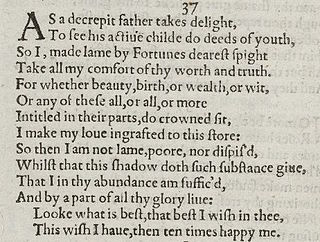
Shakespeare's Sonnet 37 returns to a number of themes sounded in the first 25 of the cycle, such as the effects of age and recuperation from age, and the blurred boundaries between lover and beloved. However, the tone is more complex than in the earlier poems: after the betrayal treated in Sonnets 34–36, the speaker does not return to a simple celebration.

William Shakespeare's Sonnet 43 employs antithesis and paradox to highlight the speaker's yearning for his beloved and sadness in their absence, and confusion about the situation described in the previous three sonnets. Sonnet 27 similarly deals with night, sleep, and dreams.

Sonnet 67 is one of 154 sonnets written by the English playwright and poet William Shakespeare. It's a member of the Fair Youth sequence, in which the poet expresses his love towards a young man and is a thematic continuation of Sonnet 66. In this poem, the speaker's anxiety about the social difference between him and his beloved takes the form of a criticism of courtly corruption. This sonnet was placed first in the pirated and mangled edition of 1640.